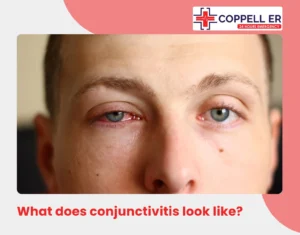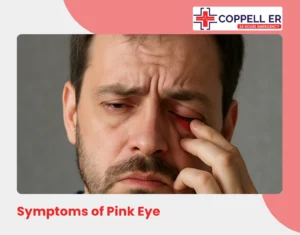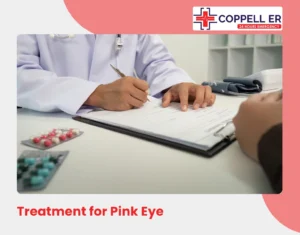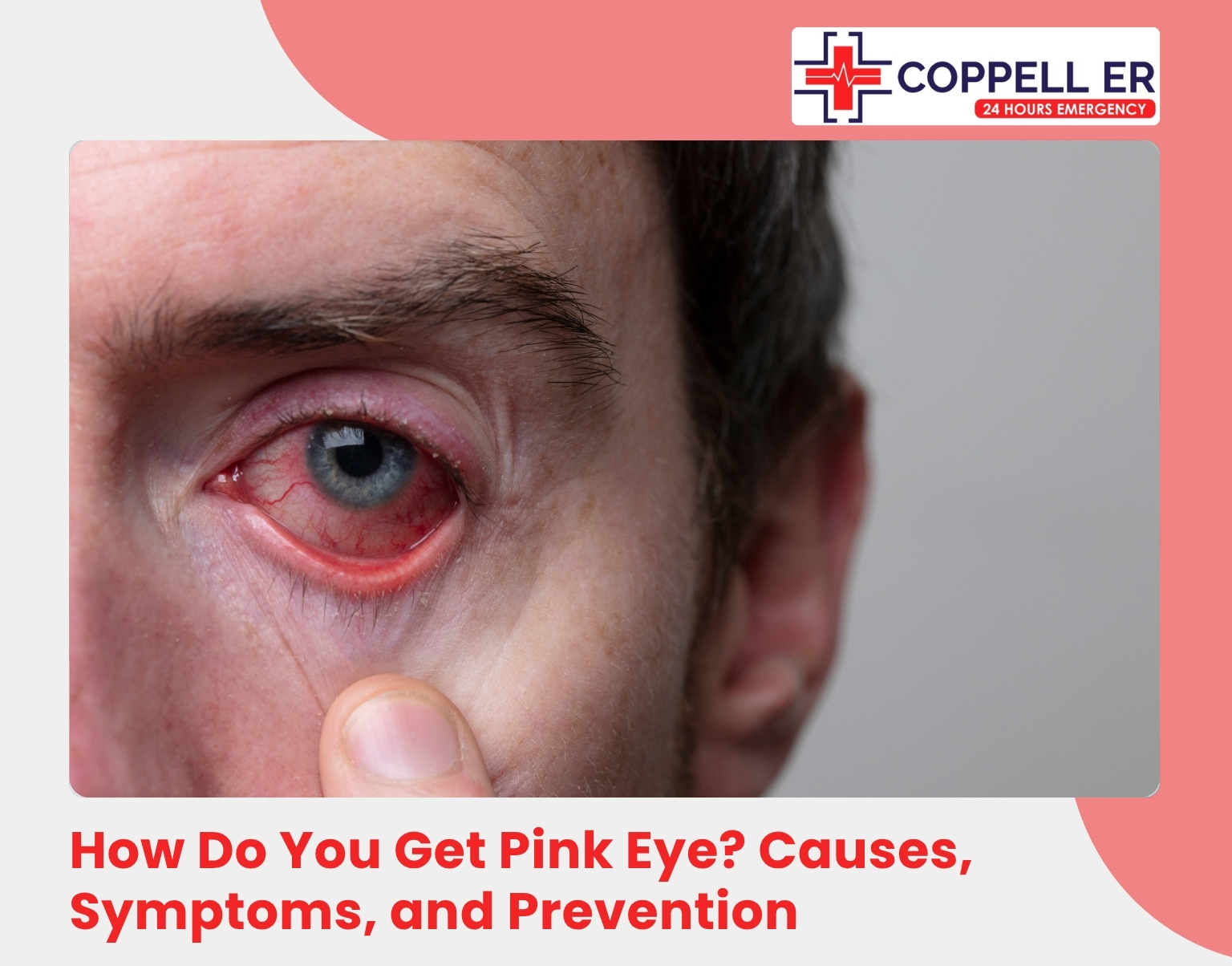Pink eye, also known as conjunctivitis, is a common eye problem that makes your eyes red and itchy. It happens when the thin layer covering the white part of your eye and inside your eyelids gets inflamed. This can make your eyes look pink or red. It’s not usually serious, but it can be uncomfortable and spread easily in some cases. Most people get better on their own, but knowing how to avoid it is key.
Pink eye can be short-term (acute) or long-term (chronic). Acute infection lasts for fewer than four weeks. Chronic pink lasts for more than four weeks.
What does conjunctivitis look like?

Pink eye caused by an infection can easily spread. You can accidentally pass it to other people or spread it from one eye to the other.
- Redness or Pink Hue
- Swelling and Puffiness
- Discharge(watery tears)
- Gritty and Blurred Vision
Types of Pink Eye
There are a few main types, each with different causes:
Type |
Cause |
Contagious? |
Common in USA? |
| Viral | Viruses like adenovirus or cold viruses | Yes | Very common, often with colds. |
| Bacterial | Bacteria, sometimes from poor contact lens care | Yes | Common in kids and adults who share items. |
| Allergic | Allergens like pollen, dust, or pet dander | No | Widespread during allergy seasons. |
| Chemical/Irritant | Chemicals, smoke, or pool chlorine | No | Happens from exposure to irritants like fumes. |
Symptoms of Pink Eye

Common symptoms include:
- Red or pink color in the white of the eye.
- Itchy or burning feeling.
- Gritty sensation, like sand in your eye.
- Watery eyes or thick discharge that crusts overnight.
- Blurred vision or sensitivity to light.
- Light sensitivity
- Swollen eyelids
- Eye pain
- Feeling like something’s stuck in your eye
How Do You Get Pink Eye? Causes
Conjunctivitis spreads in different ways depending on the type. Viral and bacterial types are the most contagious. You can get them by:
Infectious:
- Viral: The most common type, often linked to the same viruses that cause colds or sore throats. Adenovirus is a frequent culprit. It can also come from herpes or other viruses.
- Bacterial: Caused by bacteria like Staphylococcus or Streptococcus. Risk factors include not cleaning contact lenses properly or touching your eyes with dirty hands.
Noninfectious Conjunctivitis:
- Allergic: Triggered by allergens in the air, such as pollen in spring or dust mites year-round. It’s more like an allergic reaction than an infection.
- Irritant/Chemical: From exposure to things like smoke, pollution, shampoo, or pool chlorine. Giant papillary conjunctivitis is a subtype linked to long-term contact lens wear.
- Eye injuries: Anything that damages your conjunctiva can lead to conjunctivitis.
- Other conditions: Autoimmune diseases can irritate your eyes. It’s much less common, but so can tumors or eye cancers.
Complications of Conjunctivitis
Pink eye, or conjunctivitis, is usually a mild condition that resolves on its own or with basic treatment, but complications can occur if it’s left untreated, severe, or affects vulnerable groups like newborns, the elderly, or people with weakened immune systems.
- Complications include:
- Trachoma
- Uveitis
- Corneal inflammation and cornea-conjunctiva inflammation
- More severe corneal diseases, especially corneal ulcers and recurrent corneal erosions
How to Prevent Pink Eye
Good habits can help you avoid pink eye. Follow these tips from health experts:
- Wash your hands often with soap and water, especially after touching your face.
- Don’t share towels, pillowcases, or eye makeup.
- Clean contact lenses properly and don’t wear them if you have symptoms.
- Wear swim goggles in pools to avoid chlorine irritation.
- Get vaccines for related illnesses, like measles, which can lead to pink eye.
Treatment for Pink Eye

Conjunctivitis, or pink eye, is often mild and can improve with home care, but treatment depends on the cause. Your doctor may recommend ways to ease symptoms while the condition runs its course.
General Symptom Management
For most cases, focus on comfort measures at home:
- Take over-the-counter pain relievers to reduce discomfort and inflammation.
- Use warm or cool compresses on your closed eyes (use a clean cloth each time and don’t share to avoid spreading).
- Apply artificial tears (lubricating eye drops) to soothe dryness and irritation.
- Switch to glasses if you wear contact lenses, and avoid lenses until symptoms clear.
- In some cases, your doctor might prescribe corticosteroids for severe inflammation.
If pink eye is caused by an irritant or chemical splash, rinse your eyes immediately with lukewarm water for at least 5 minutes.
Targeted Treatments by Cause
Your provider may prescribe medications based on the specific type of conjunctivitis. Here’s a breakdown:
Cause |
Treatment Options |
Notes |
| Viral | Usually no specific meds; antivirals only for cases like herpes, varicella (chickenpox/shingles), or certain STIs to prevent complications. | Self-resolves in 1-3 weeks; focus on hygiene to avoid spread. |
| Bacterial | Antibiotic eye drops, ointments (e.g., fluoroquinolones), or oral pills for severe infections. | For gonococcal or chlamydial types, systemic antibiotics are needed. |
| Fungal or Parasitic | Antifungal or antiparasitic medications tailored to the infection. | Rare; requires lab confirmation. |
| Allergic | Over-the-counter or prescription antihistamines, decongestants, or mast cell stabilizers. | Avoid allergens; eye drops help reduce itching and swelling. |
| Autoimmune-Related | Immunosuppressant drugs to control immune response and protect eye tissues. | Used for chronic or underlying conditions like rheumatoid arthritis. |
When to See a Doctor
Most pink eye is mild, but see a doctor if:
- Symptoms get worse after a few days.
- You have severe pain, blurred vision, or lots of discharge.
- You’re a contact lens wearer, and symptoms don’t improve in 12-24 hours.
- It’s a newborn with symptoms.
FAQs
What is the most common way to get pink eye?
The most common way is through viral infections, like from a cold, spreading via touch or shared items.
Is pink eye contagious?
Yes, viral and bacterial types are contagious, but allergic pink eye is not.
How long does pink eye last?
It usually lasts 7-10 days, but can be up to two weeks for viral cases.
Can pink eye go away on its own?
Yes, especially viral pink eye, but see a doctor if symptoms are severe.
How can I prevent spreading pink eye to my family?
Wash hands often, don’t share towels or makeup, and stay home if contagious.




